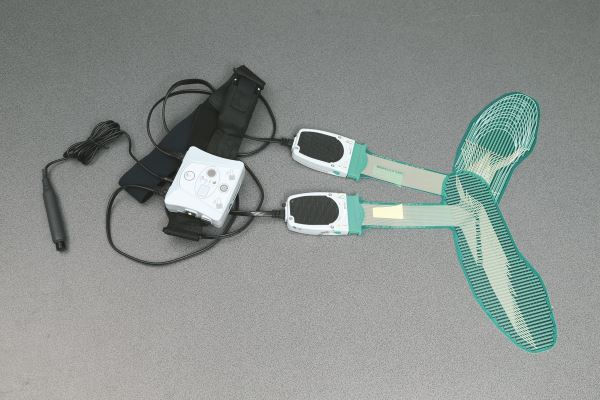SATRA's pressure mapping capabilities
Describing SATRA's new pressure mapping equipment and the value of using this tool when designing footwear.
by David Smith

In-shoe pressure mapping is a powerful diagnostic tool that has been used for many years in such fields as footwear testing, footwear design, podiatry, chiropody, patient rehabilitation, gait analysis and sports science. The ability to visualise and measure underfoot force and pressure has been invaluable to many researchers and medical personnel wanting to better understand the dynamics of underfoot forces and foot-shoe interaction. It offers an excellent way of quantifying the comfort of footwear.
SATRA has used in-shoe pressure mapping equipment for some time – in our own research projects, to assist customers with product development and in standard testing such as SATRA TM190:2002 – ‘SATRA ground insulation index’, where the ability of a sole unit to protect the user from ‘feel-through’ when on uneven ground is assessed. Too much feel-through can lead to discomfort for the wearer, whereas too much ground insulation could isolate the user from picking up valuable characteristics of the underfoot conditions.
As in-shoe pressure sensors can be trimmed to fit most sizes and types of footwear, they have found application in a wide range of products, from children’s footwear to high-heeled shoes and wellington boots. Underfoot pressure data is extremely useful for evaluating the difference between various cushioning components (such as sculpted footbeds) or different types of midsole material or cushioning gel inserts. As mentioned, it is also an effective way of quantifying feel-through in footwear. This can be of particular interest when making products such as studded sports footwear, on which studs/cleats on the bottom of the outsole could have an effect inside the footwear on the comfort of the wearer.
Underfoot pressure mapping has also been used in the testing of innovative footwear incorporating electronics, such as footbeds containing batteries and other components, all of which could have a potentially detrimental effect on underfoot comfort. In one series of tests, 3D-printed models of a number of different batteries were incorporated into footbeds so that comfort testing could be carried out during bespoke jumping exercises and walking protocols, tailored to the demands of the product. Testing of this kind can be used to help verify market claims, especially those relating to comfort.
Limitations of tethered equipment
While the equipment used for pressure mapping is extremely versatile (and can be used for testing in a variety of applications), it does have its limitations. Most notably, traditional in-shoe sensors and equipment must remain tethered to the computer at all times via a six-metre-long cable. While this may not be an issue when the test subject is walking on a treadmill or within a laboratory, it does preclude carrying out pressure mapping on subjects who are moving erratically, travelling over an extended distance, walking on anything other than a level surface, or when he or she is moving at high speeds. Fixed cable length limits the subject’s ability to get into a natural stride or to reach what they feel is a comfortable walking speed.
SATRA has recently invested in new pressure mapping equipment that enables the remote collection of underfoot pressure data from test subjects (figure 1). This uses a datalogger unit carried on the test subject’s belt that stores the data gathered during the exercise for later download. The same ultra-thin cut-to-size sensors as before are used.

Figure 1: SATRA has invested in new pressure mapping equipment that enables the remote collection of data from test subjects. Instead of the sensors being tethered to a computer via a cable, the data is gathered and stored by a small unit carried on a belt by the test subject.
The wearer is able to set off on a test walk or run, and then press to a switch to choose the moment to start recording data. This might be at a critical point, such as landing from a jump, or it could just be when the subject feels that he or she has walked for a sufficient length of time to have fallen into a comfortable pace. Recordings can last for up to two hours, after which the subject returns to the laboratory and all the data is downloaded for analysis.
This obviously opens up great potential for a whole range of testing previously not possible. For example, underfoot pressure data can be recorded from subjects walking up and down stairs, running, cycling, embarking on an obstacle course, climbing ladders, kicking a ball or walking for long distances.
Customers wanting to validate new designs or wishing to gather data from real-world environments and from end user applications should consider joining the thousands of other satisfied customers who have already benefited from having pressure assessments carried out with this new equipment. Remote pressure mapping offers a level of freedom previously unobtainable by conventional research tools, and gives exciting scope for bespoke testing solutions and assistance with product development.

Collecting data from pressure mapping of footwear
Pressure mapping can be used to answer many questions about product performance. It can also provide invaluable data that can be used to validate marketing claims, or simply to establish the difference between two similar designs, materials or constructions.
How can we help?
Please email research@satra.com for more information on the use of in-shoe pressure mapping.
Publishing Data
This article was originally published on page 8 of the January 2019 issue of SATRA Bulletin.
Other articles from this issue »


 EN
EN ZH
ZH